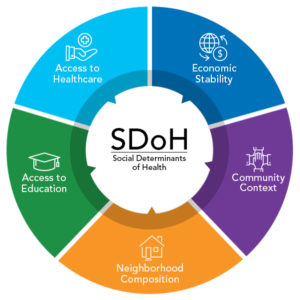The theme of World Health Day for 2021 is “building a fairer, healthier world.” Yet, around the globe, communities face disadvantages and inequities to quality healthcare. In the United States, these health inequities are referred to as social determinants of health (SDOH).
I sat down with Director of Clinical Programs, Christine DiNoia, BSN, RN, and Clinical Engagement Manager, Shelley Davis, MSN, RNC, CCM, on the Population Health Management Podcast to discuss this important theme. Together, we defined what comprises SDOH, the impact of the value-based care approach on tending to these vulnerable populations, and how Lightbeam helps our clients intervene where they are needed most.
To start things off, how do we define social determinants of health?

Shelley: Formally, social determinants of health are divided into five areas: a person’s financial security, neighborhood composition, community contexts, and access to quality education and health care. These factors can impact a person’s quality of life, physical health, mental health, and spiritual wellbeing.
To fully understand what SDOH means, one must assess the whole person. From where they live to who they are mentally, physically, spiritually, and emotionally. Once you do that, you see firsthand how each of these areas can affect a person, often for the worse. Fundamentally, a person with SDOH challenges will have less access to nutritious and fresh foods, quality education, safe neighborhoods, community engagement, transportation, and social support.
1 in 10 Americans lives in poverty. If a person faces economic instability, they have fewer opportunities for quality housing and safe environments for themselves and their families. If a person cannot have quality education from an early age, they may choose to drop out or attain fewer high-paying job opportunities down the road.
Research shows those who grow up with SDOH disparities and have lacked access to education are more likely to struggle with everyday tasks that require reading and mathematics. Living with the stress of these insecurities further impacts education and career performance.
Christine: When a person lacks access to safe housing, a healthy diet, a fostering community, reliable transportation, quality education, and healthcare, poor health outcomes are not far behind. Providers are increasingly held accountable for reaching population health goals while reducing costs. They must have tools and strategies to identify the upstream socioeconomic drivers of poor outcomes and higher costs.
Research indicates patients with more significant SDOH impacts are less likely to have a primary care physician (PCP), utilize preventative care services, and face language and literacy barriers. These make our area of expertise, care management, so critical. Care managers and physicians have a unique one-on-one impact that helps a patient feel supported and looked after. Once they feel more comfortable, care managers can address the outstanding care gaps that improve outcomes and costs.
Who are some of the most vulnerable groups that healthcare organizations should target?
Shelley: Some of these groups include those living below the poverty line, dual-eligible patients for Medicare and Medicaid, elderly patients on a fixed income or whose healthcare costs exceed their income, and patients with disabilities.
The basic promotion of health care practices is not enough to resonate with these communities. It takes creativity to manage chronic conditions successfully and out-of-box thinking to meet beneficiaries where they are. Examples of this include the increased adoption of telehealth, which was once exclusive to patients in rural areas. In addition, some non-profits address specific needs, like food insecurity and transportation.
A healthcare organization is only as healthy as the community it serves. Thankfully, we have witnessed increased awareness for SDOH on an organizational and legislative level. New state and federal laws require an enhanced focus on addressing disparities in local communities. They offer a promising snapshot of the impact the coordination has on SDOH populations.
How does Lightbeam play a part in the population health management of SDOH patients?
Christine: With the amount of data we ingest on social determinants of health, our clients can define and document their patients’ complexity and transform how they receive care. Integrated services and community partnerships continually demonstrate the value they bring to patients, communities, and payers.
We utilize the Protocol for Responding to and Assessing Patients’ Assets, Risks, and Experiences (PRAPARE) form as the core of our assessments within the platform. The PRAPARE tool is a scorable assessment that consists of national and optional measures based on the client’s priorities.
When each question is answered, it provides the care manager with a score at the bottom. They can then take the total score to drive action or pull any of the questions into a cohort. The PRAPARE form is also compatible with Aunt Bertha community resources.
For more information on how Lightbeam’s Clinical Transformation team crafts initiatives around SDOH, email clinicaltransformation@lightbeamhealth.com, and visit the links below for additional resources if you or someone you know requires assistance.

Laurel Derr is Lightbeam’s Marketing & Event Coordinator.
